VMware 5V0-41-20 Exam Questions
Questions for the 5V0-41-20 were updated on : Jul 02 ,2025
Page 1 out of 3. Viewing questions 1-15 out of 36
Question 1
Scenario:1
A network administrator is tasked with enabling SD-WAN at three branch locations, A topology has
been provided for reference. For each site, the administrator is having issues bringing edges online,
as another administrator has gone ahead and created a configuration ahead of time. The
organization has several branch sites. One is an Internet-only site and two are Hybrid locations with
both internet and MPLS. The last location is MPLS only. There are hub data center in this
environment as well. Please refer to the topology.
Exhibit.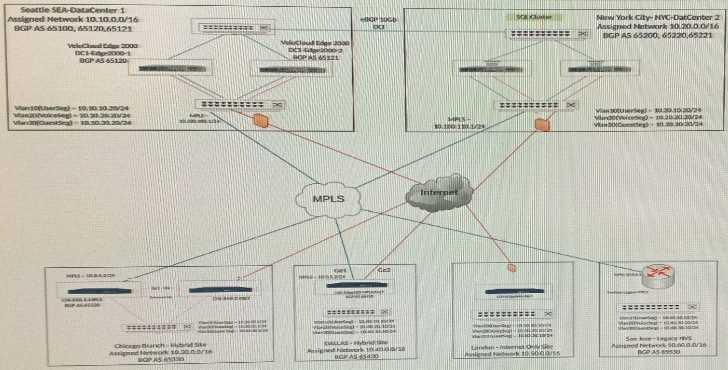
One of the Edges at the Chicago site is unable to activate. The Edge has a red LED. What is the next
troubleshooting step?
- A. If the Edge is connected to its HA peer, determine if there is a link-light on the HA peer-link.
- B. If the Edge is connected to the MPLS circuit, determine if the Hub is advertising gateway routes.
- C. If the Edge is connected to the MPLS circuit which does not have DHCP, determine if there is a static IP configuration that needs to be applied upon activation.
- D. If the Edge is connected to its HA peer, determine if underlay BGP peering is present between the two Edges.
Answer:
C
Question 2
Scenario 3:
After resolving numerous connectivity issues throughout the various branch sites, connectivity
between applications and users is finally present. The network administrator is informed that during
certain tests, applications are not performing as they are expected to. Users report that call quality
has not fully improved and that some of their calls either drop or have poor voice quality where the
conversation is breaking up. Other users are noticing that file transfers are slower than expect. A
group of users from a few sites have reported slowness in accessing internal and external
applications.
Exhibit.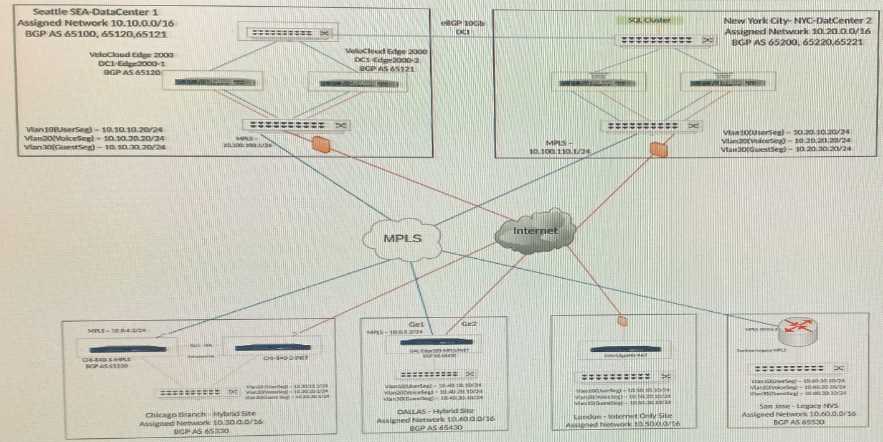
A network engineer is configuring an Internet Backhaul Policy for the Chicago Branch to utilize NY's
hub as a much better source for Internet for certain SaaS applications. For an unknown reason, the
network engineer is not able to select the hubs in the Internet Backhaul Policy.
What could be the reason?
- A. The Dynamic Branch to Branch has not been enabled.
- B. The hub is not configured with the proper IP address.
- C. Dynamic Branch to Branch using gateways has not been enabled.
- D. The Edge's profile does not include Backhaul hubs as an option.
Answer:
C
Question 3
Scenario 2:
After completing the branch activation for all required branches, the network administrator attempts
to test connectivity between the various branches and between hubs and branches. The
administrator notices a lack of connectivity despite being certain that configurations have been
complete. The administrator also observed that several users are reporting intermittent connectivity
to some of the some applications they are accessing. Other users are reporting no access to these
applications. Other users at some of the branches claim they cannot get to certain public resources.
The administrator wants to ensure that all sites can talk to each other and all resources are
accessible.
Exhibit.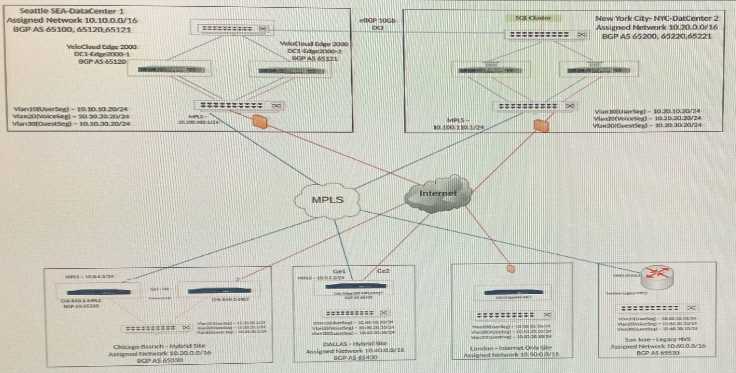
A technician has added Edges to an East Coast Profile. These Edges are not able to communicate via
dynamic tunnels to Edges in the West_Coast profile. The technician has noticed that some Edges are
able to establish dynamic tunnels.
What could be preventing Edges from being able to establish dynamic tunnels?
- A. The profiles are not configured to allow dynamic branch to branch VPNs.
- B. The profiles are configured to only allow dynamic branch to branch for Edges within the same profile.
- C. None of the existing profiles have Cloud VPN enabled thus preventing dynamic tunnels.
- D. Neither profile has been configured to utilize cloud gateways.
Answer:
B
Question 4
Scenario 3:
After resolving numerous connectivity Issues throughout the various branch sites, connectivity
between applications and users is finally present. The network administrator is informed that during
certain tests, applications are not performing as they are expected to. Users report that call quality
has not fully improved and that some of their calls either drop or have poor voice quality where the
conversation is breaking up. Other users are noticing that file transfers are slower than expect. A
group of users from a few sites have reported slowness in accessing internal and external
applications.
Exhibit.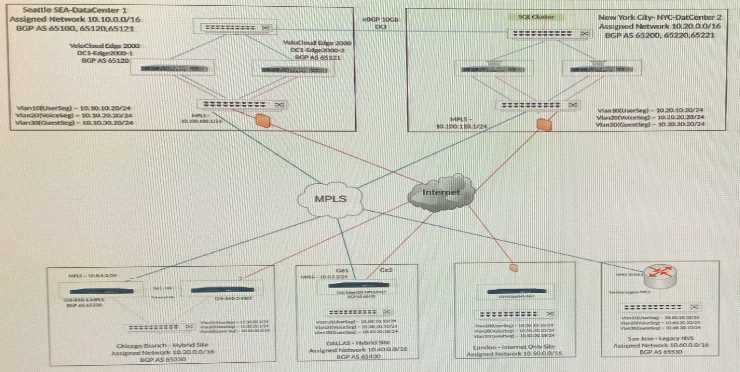
The network administrator has been made aware that Chicago is receiving traffic from non-SD-WAN
sites, bottlenecking Chicago's interfaces. The network administrator's VMware SE has mentioned
using the uplink feature to help resolve this.
What are two ways the uplink feature should be used in this scenario? (Choose two.)
- A. Set the uplink community to forward traffic to a group of neighbors.
- B. Direct all traffic to that neighbor designated as an uplink,
- C. Stop mutual redistribution of routes from underlay and overlay.
- D. Prevent the site in question from becoming a transit site.
Answer:
B, D
Question 5
Scenario 3:
After resolving numerous connectivity issues throughout the various branch sites, connectivity
between applications and users is finally present. The network administrator is informed that during
certain tests, applications are not performing as they are expected to. Users report that call quality
has not fully improved and that some of their calls either drop or have poor voice quality where the
conversation is breaking up. Other users are noticing that file transfers are slower than expect. A
group of users from a few sites have reported slowness in accessing; internal and external
applications.
Exhibit.
A network administrator is configuring several branches to prefer a single prefix, 10.20.11.0/24,
from the Seattle hub over the New York hub for various application performance reasons.
What are two effective ways the administrator can accomplish this? (Choose two.)
- A. Modify the AS Path in New York to be shorter for 10.20.11.0/24.
- B. In the hub preferred order in the profile, set the Seattle hub to be preferred over New York.
- C. Modify the AS Path in New York to be longer for 10.20.11.0/24.
- D. In the OFC 10.20.11.0/24, modify the preferred exit point to be Seattle and pin the route.
Answer:
B, D
Question 6
Scenario 3:
After resolving numerous connectivity issues throughout the various branch sites, connectivity
between applications and users is finally present. The network administrator is informed that during
certain tests, applications are not performing as they are expected to. Users report that call quality
has not fully improved and that some of their calls either drop or have poor voice quality where the
conversation is breaking up. Other users are noticing that file transfers are slower than expect. A
group of users from a few sites have reported slowness in accessing internal and external
applications.
Exhibit.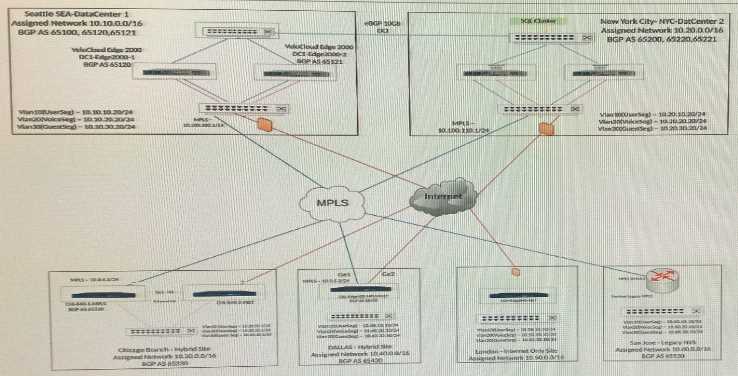
Users at a remote office are complaining about poor performance with certain applications. The
network administrator has already configured Business Policies based on these requirements.
What is the sequence of parameters that the administrator can check to troubleshoot this problem?
(Choose two.)
- A. Change the bandwidth measurement under WAN Overlay Advanced Settings.
- B. Check underlay network (bandwidth, latency, jitter, packet loss).
- C. Under Monitor, check Routing tab.
- D. Review Business Policies configuration and match them against the business requirements.
Answer:
B, D
Question 7
Scenario 3:
After resolving numerous connectivity issues throughout the various branch sites, connectivity
between applications and users is finally present. The network administrator is informed that during
certain tests, applications are not performing as they are expected lo. Users report that call quality
has not fully improved and that some of their calls either drop or have poor voice quality where the
conversation is breaking up. Other users are noticing that file transfers are slower than expect. A
group of users from a few sites have reported slowness in accessing internal and external
applications.
Exhibit.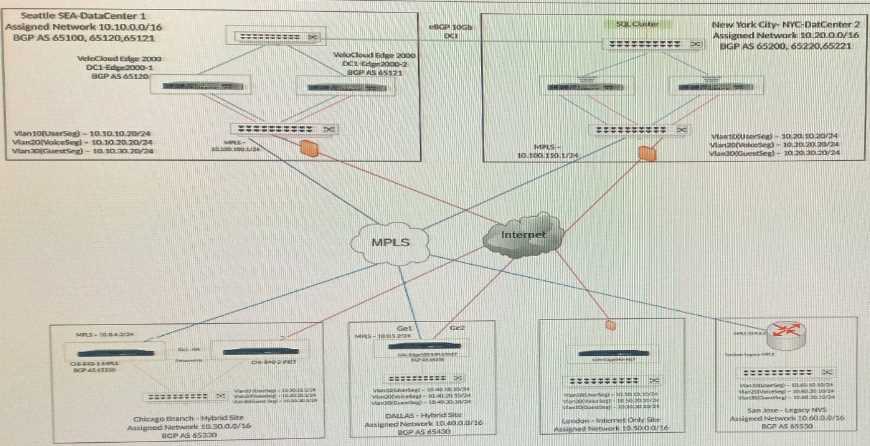
Users are complaining that web pages to certain web sites are very slow to load and at times
unresponsive. The network administrator has verified that the traffic is going correctly out the
underlay.
What should the administrator check next?
- A. Verify if Path-MTU Discovery is disabled.
- B. Verify if there is latency, loss, or jitter on the underlay.
- C. Verify the Business Policy flows are matching.
- D. Verify if routes to Gateways are present in the Overlay Flow Control (OFC).
Answer:
A
Question 8
Scenario 1:
A network administrator is tasked with enabling SD-WAN at three branch locations. A topology has
been provided for reference. For each site, the administrator is having issues bringing edges online,
as another administrator has gone ahead and created a configuration ahead of time. The
organization has several branch sites. One is an Internet-only site and two are Hybrid locations with
both internet and MPLS. The last location is MPLS only. There are hub data center locations in this
environment as well. Please refer to the topology.
Exhibit.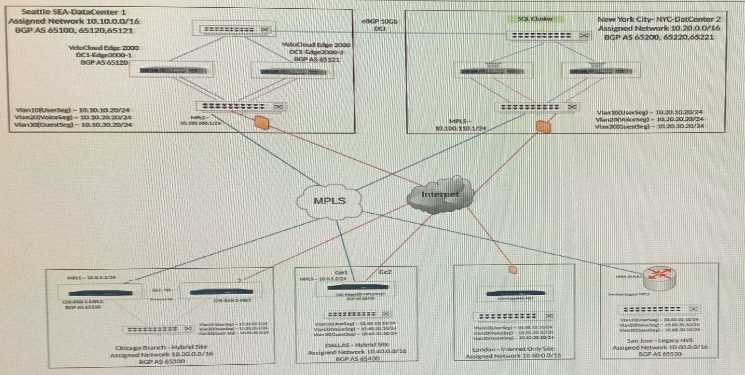
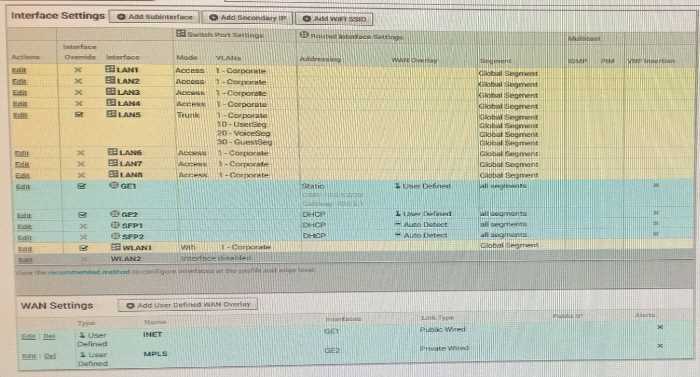
The network administrator determines the issue preventing the Dallas Branch from coming online.
Refer to the Exhibit(s).
What must the administrator do for the Edge to communicate with the Orchestrator and other
branches?
- A. Reverse the WAN Overlay configurations
- B. Update the Orchestrator to the latest version as it enables "Auto WAN Swapping"
- C. Delete the User Defined WAN Overlays as the Orchestrator will discover these automatically on MPLS and Internet
- D. Create a User-defined WAN Overlay to bond both interfaces
Answer:
A
Question 9
Scenario 2:
After completing the branch activation activities for all required branches, the network administrator
attempts to test connectivity between the various branches and between the hubs and branches.
The administrator notices a lack of connectivity despite being certain that configurations have been
complete. The administrator also observed that several users are reporting intermittent connectivity
to some of the applications they are accessing. Other users are reporting no access to these
applications. Other users at some of the branches claim they cannot get to certain public resources.
The administrator wants to ensure that all sites can talk to each other and all resources are
accessible.
Exhibit.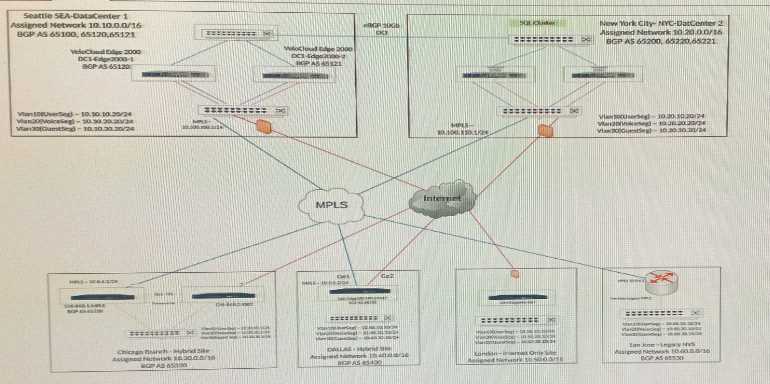
A network administrator has received an email from the applications development team requesting
connectivity to their AWS VPC.
The administrator has configured the tunnel via the VMware SD-WAN Gateway. The tunnel status
icon has not turned green.
Where are two places the administrator must check? (Choose two.)
- A. Determine if the DH parameter on the Edge has been configured.
- B. Determine if the PSK is mismatched between the AWS side and the VeloCloud Edge.
- C. Determine if the NVS has been enabled and assigned to a profile.
- D. Determine if the PSK is mismatched between the AWS side and the VeloCloud Gateway.
Answer:
B, D
Question 10
Scenario 2:
After completing the branch activation activities for all required branches, the network administrator
attempts to test connectivity between the various branches and between the hubs and branches.
The administrator notices a lack of connectivity despite being certain that configurations have been
complete. The administrator also observed that several users are reporting intermittent connectivity
to some of the applications they are accessing. Other users are reporting no access to these
applications. Other users at some of the branches claim they cannot gel to certain public resources.
The administrator wants to ensure that all sites can talk to each other and all resources are
accessible.
Exhibit.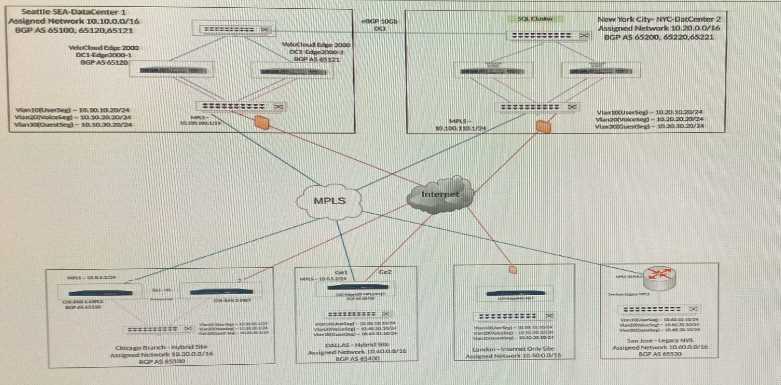
A business policy is created and saved.
How can the network administrator verify the business policy is working?
- A. Select a VCE > Test & Troubleshoot > Remote diagnostics and select List Active flows and check the flows to see what Business policy is applied under the Business policy column.
- B. Executing Route table dump under VCE > Test St Troubleshoot > Remote Diagnostics and select Route Table dump and look for business policy applied in the Route table Dump stats.
- C. Check under Monitor > Applications tab and check the listing of applications at the bottom of the screen and the category of the type of traffic there.
- D. Check under the Monitor > Business Priority tab for Business policy statistics.
Answer:
B
Question 11
Scenario 3:
After resolving numerous connectivity issues throughout the various branch sites, connectivity
between applications and users is finally present. The network administrator is informed that during
certain tests, applications are not performing as they are expected to. Users report that call quality
has not fully improved and that some of their calls either drop or have poor voice quality where the
conversation is breaking up. Other users are noticing that file transfers are slower than expect. A
group of users from a few sites have reported slowness in accessing internal and external
applications.
Users at multiple branches complain that a highly performant SQL Database cluster residing at the
New York Data Center is not responding to database queries or inserts as expected. It is affecting the
order management site. A network administrator investigates and finds that traffic from the
branches are going through Seattle to reach the SQL Cluster in New York. The design for this SD-WAN
network does not call for routing security.
The SQL Cluster is reachable through either Data Center, but for performance reasons, must flow
through the New York DC. The network administrator has verified that the routes are not present in
the OFC and the BGP neighborship is down in Network Services.
Refer to the Exhibit(s).
Exhibit.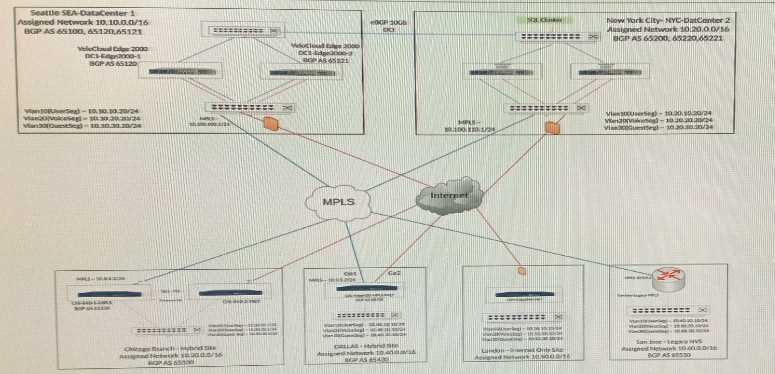
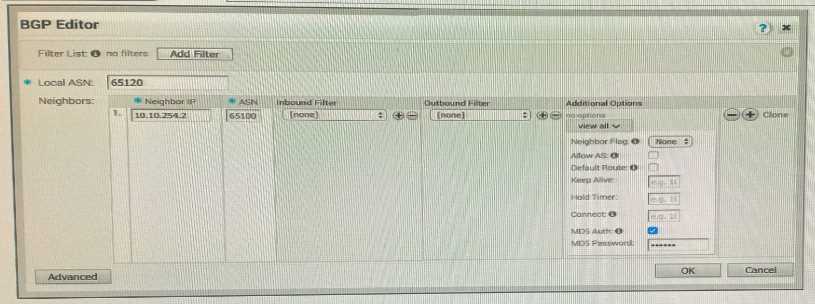
What should the administrator verify?
- A. The BGP configuration has a filter in place to deny the prefix in New York.
- B. The BGP Authentication matches on both sides.
- C. The BGP configuration has a filter in place to deny the prefix in Seattle.
- D. Backhauling through the Seattle DC is disabled.
Answer:
D
Question 12
Scenario 3:
After resolving numerous connectivity Issues throughout the various branch sites, connectivity
between applications and users is finally present. The network administrator is informed that during
certain tests, applications are not performing as they are expected to. Users report that call quality
has not fully improved and that some of their calls either drop or have poor voice quality where the
conversation is breaking up. Other users are noticing that file transfers are slower than expect. A
group of users from a few sites have reported slowness in accessing internal and external
applications.
Exhibit.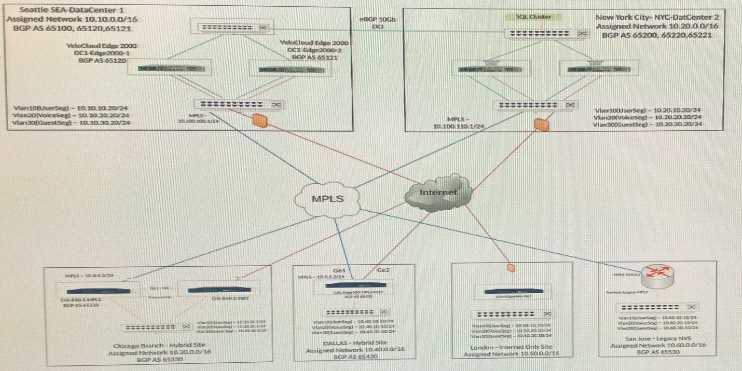
Users at a remote office are complaining about poor performance with certain applications. The
network administrator has already verified the configuration is correct.
Which two parameters should the administrator review to troubleshoot this issue? (Choose two.)
- A. Check the underlay network (bandwidth, latency, jitter, packet loss)
- B. Change the bandwidth measurement under WAN Overlay Advanced Settings
- C. Check the flows to verify which Business Policy the traffic of interest is matching
- D. Look under Monitor, check Business priority tab
Answer:
A, D
Question 13
Scenario 3:
After resolving numerous connectivity Issues throughout the various branch sites, connectivity
between applications and users is finally present- The network administrator is informed (hat during
certain tests, applications are not performing as they are expected to. Users report that call quality
has not fully improved and that some of their calls either drop or have poor voice quality where the
conversation is breaking up. Other users are noticing that file transfers are slower than expect. A
group of users from a few sites have reported slowness in accessing internal and external
applications.
Exhibit.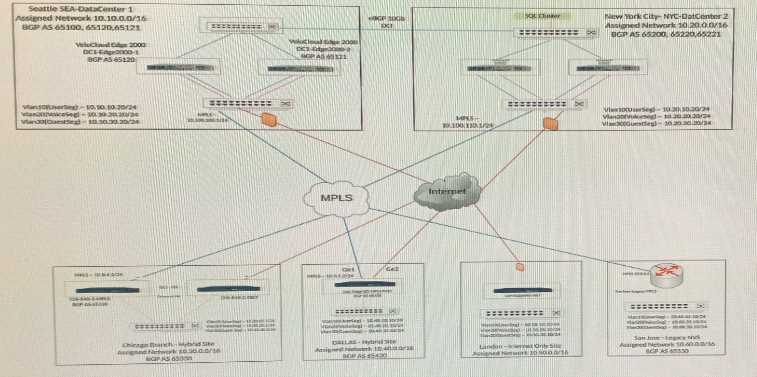
Which metrics can a network administrator verify in the QoE screen to determine the overall health
of Underlay and Overlay?
- A. Jitter Packet Loss, Speed.
- B. Jitter, Packet Loss, Latency.
- C. Jitter, Speed, Latency.
- D. Packet Loss, Latency, Speed.
Answer:
B
Question 14
Scenario 2:
After completing the branch activation activities for all required branches, the network administrator
attempts to test connectivity between the various branches and between the hubs and branches.
The administrator notices a lack of connectivity despite being certain that configurations have been
complete. The administrator also observed that several users are reporting intermittent connectivity
to some of the applications they are accessing. Other users are reporting no access to these
applications. Other users at some of the branches claim they cannot get to certain public resources.
The administrator wants to ensure that all sites can talk to each other and all resources are
accessible.
Exhibit.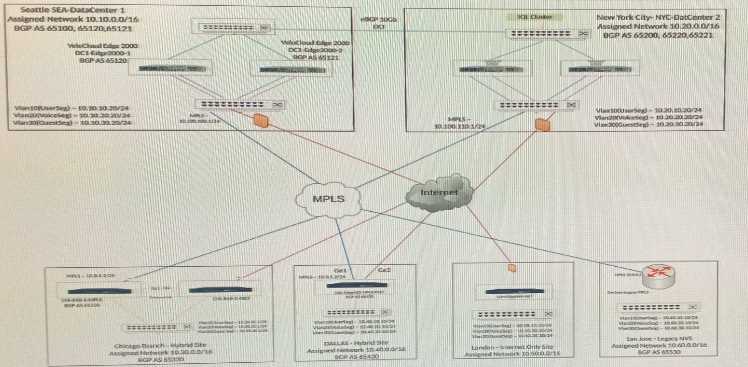
The tunnel from spoke to hub is not coming up. What are the two possible reasons? (Choose two.)
- A. Spoke Edge and hub Edge are two different Edge models.
- B. Spoke Edge and hub Edge have a mismatch certificate authentication mode.
- C. Hub WAN Interface might be behind the NAT Device or firewall.
- D. Dynamic Branch to Branch is not enabled.
Answer:
B, C
Question 15
Scenario 2:
After completing the branch activation activities for all required branches, the network administrator
attempts to test connectivity between the various branches and between the hubs and branches.
The administrator notices a lack of connectivity despite being certain that configurations have been
complete. The administrator also observed that several users are reporting intermittent connectivity
to some of the applications they are accessing. Other users are reporting no access to these
applications. Other users at some of the branches claim they cannot get to certain public resources.
The administrator wants to ensure that all sites can talk to each other and all resources are
accessible.
Exhibit.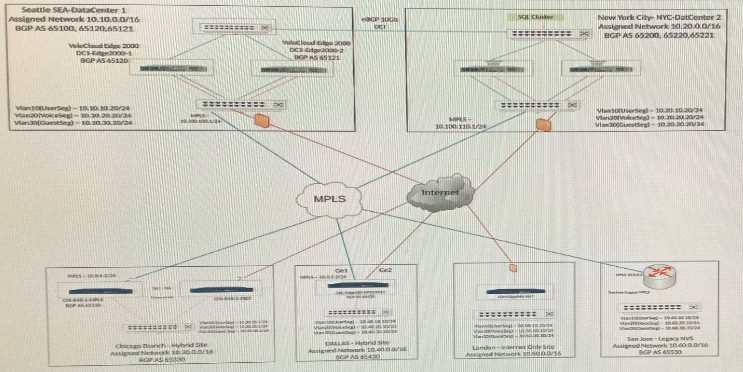
A network administrator decides to deploy a local Checkpoint VNF appliance on the Edge in London
to cut back on unnecessary traffic towards the NY Hub location. While attempting to deploy the VNF,
the process keeps failing.
Where can the administrator check to see more detail?
- A. VCO > Monitor > Logging
- B. VCO > Monitor > Events
- C. VCO > Test & Troubleshoot > Remote Diagnostics > Events
- D. VCO > Test & Troubleshoot > Remote Actions > Alerts
Answer:
B